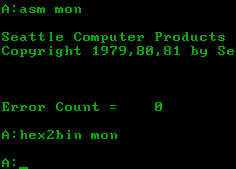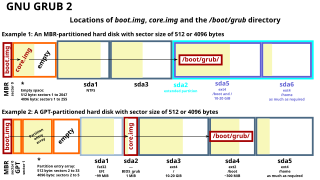
In computing, BIOS is firmware used to provide runtime services for operating systems and programs and to perform hardware initialization during the booting process. The BIOS firmware comes pre-installed on an IBM PC or IBM PC compatible's system board and exists in some UEFI-based systems too as a compatibly support module to maintain compatibility operating systems that do not support UEFI native operation. The name originates from the Basic Input/Output System used in the CP/M operating system in 1975. The BIOS originally proprietary to the IBM PC has been reverse engineered by some companies looking to create compatible systems. The interface of that original system serves as a de facto standard.

In computing, booting is the process of starting a computer as initiated via hardware such as a button or by a software command. After it is switched on, a computer's central processing unit (CPU) has no software in its main memory, so some process must load software into memory before it can be executed. This may be done by hardware or firmware in the CPU, or by a separate processor in the computer system.
File Allocation Table (FAT) is a file system developed for personal computers. Originally developed in 1977 for use on floppy disks, it was adapted for use on hard disks and other devices. It is often supported for compatibility reasons by current operating systems for personal computers and many mobile devices and embedded systems, allowing interchange of data between disparate systems. The increase in disk drives capacity required three major variants: FAT12, FAT16 and FAT32. The FAT standard has also been expanded in other ways while generally preserving backward compatibility with existing software.

86-DOS is a discontinued operating system developed and marketed by Seattle Computer Products (SCP) for its Intel 8086-based computer kit.

A boot sector is the sector of a persistent data storage device which contains machine code to be loaded into random-access memory (RAM) and then executed by a computer system's built-in firmware.

GNU GRUB is a boot loader package from the GNU Project. GRUB is the reference implementation of the Free Software Foundation's Multiboot Specification, which provides a user the choice to boot one of multiple operating systems installed on a computer or select a specific kernel configuration available on a particular operating system's partitions.
Logical block addressing (LBA) is a common scheme used for specifying the location of blocks of data stored on computer storage devices, generally secondary storage systems such as hard disk drives. LBA is a particularly simple linear addressing scheme; blocks are located by an integer index, with the first block being LBA 0, the second LBA 1, and so on.

A bootloader, also spelled as boot loader or called boot manager and bootstrap loader, is a computer program that is responsible for booting a computer.
In computing, the BIOS parameter block, often shortened to BPB, is a data structure in the volume boot record (VBR) describing the physical layout of a data storage volume. On partitioned devices, such as hard disks, the BPB describes the volume partition, whereas, on unpartitioned devices, such as floppy disks, it describes the entire medium. A basic BPB can appear and be used on any partition, including floppy disks where its presence is often necessary; however, certain filesystems also make use of it in describing basic filesystem structures. Filesystems making use of a BIOS parameter block include FAT12, FAT16, FAT32, HPFS, and NTFS. Due to different types of fields and the amount of data they contain, the length of the BPB is different for FAT16, FAT32, and NTFS boot sectors. Combined with the 11-byte data structure at the very start of volume boot records immediately preceding the BPB or EBPB, this is also called FDC descriptor or extended FDC descriptor in ECMA-107 or ISO/IEC 9293.

IBMBIO.COM is a system file in many DOS operating systems. It contains the system initialization code and all built-in device drivers. It also loads the DOS kernel (IBMDOS.COM) and optional pre-loadable system components, displays boot menus, processes configuration files and launches the shell.

Cylinder-head-sector (CHS) is an early method for giving addresses to each physical block of data on a hard disk drive.
An Option ROM for the PC platform is a piece of firmware that resides in ROM on an expansion card, which gets executed to initialize the device and (optionally) add support for the device to the BIOS. In its usual use, it is essentially a driver that interfaces between the BIOS API and hardware. Technically, an option ROM is firmware that is executed by the BIOS after POST and before the BIOS boot process, gaining complete control of the system and being generally unrestricted in what it can do. The BIOS relies on each option ROM to return control to the BIOS so that it can either call the next option ROM or commence the boot process. For this reason, it is possible for an option ROM to keep control and preempt the BIOS boot process. The BIOS generally scans for and initializes option ROMs in ascending address order at 2 KB address intervals within two different address ranges above address C0000h in the conventional (20-bit) memory address space; later systems may also scan additional address ranges in the 24-bit or 32-bit extended address space.

The Rainbow 100 is a microcomputer introduced by Digital Equipment Corporation (DEC) in 1982. This desktop unit had a monitor similar to the VT220 and a dual-CPU box with both 4 MHz Zilog Z80 and 4.81 MHz Intel 8088 CPUs. The Rainbow 100 was a triple-use machine: VT100 mode, 8-bit CP/M mode, and CP/M-86 or MS-DOS mode using the 8088.

The GUID Partition Table (GPT) is a standard for the layout of partition tables of a physical computer storage device, such as a hard disk drive or solid-state drive, using universally unique identifiers, which are also known as globally unique identifiers (GUIDs). Forming a part of the Unified Extensible Firmware Interface (UEFI) standard, it is nevertheless also used for some BIOS systems, because of the limitations of master boot record (MBR) partition tables, which use 32 bits for logical block addressing (LBA) of traditional 512-byte disk sectors.
INT 13h is shorthand for BIOS interrupt call 13hex, the 20th interrupt vector in an x86-based computer system. The BIOS typically sets up a real mode interrupt handler at this vector that provides sector-based hard disk and floppy disk read and write services using cylinder-head-sector (CHS) addressing. Modern PC BIOSes also include INT 13h extension functions, originated by IBM and Microsoft in 1992, that provide those same disk access services using 64-bit LBA addressing; with minor additions, these were quasi-standardized by Phoenix Technologies and others as the EDD BIOS extensions.
An extended boot record (EBR), or extended partition boot record (EPBR), is a descriptor for a logical partition under the common DOS disk drive partitioning system. In that system, when one partition record entry in the master boot record (MBR) is designated an extended partition, then that partition can be subdivided into a number of logical partitions. The actual structure of that extended partition is described by one or more EBRs, which are located inside the extended partition. The first EBR will always be located on the very first sector of the extended partition.
The partition type in a partition's entry in the partition table inside a master boot record (MBR) is a byte value intended to specify the file system the partition contains or to flag special access methods used to access these partitions.

DOS is a platform-independent acronym for "disk operating system" that later became a common shorthand for disk-based operating systems on IBM PC compatibles. DOS primarily consists of Microsoft's MS-DOS and a rebranded version under the name IBM PC DOS, both of which were introduced in 1981. Later compatible systems from other manufacturers include DR DOS (1988), ROM-DOS (1989), PTS-DOS (1993), and FreeDOS (1998). MS-DOS dominated the IBM PC compatible market between 1981 and 1995.
A master boot record (MBR) is a special type of boot sector at the very beginning of partitioned computer mass storage devices like fixed disks or removable drives intended for use with IBM PC-compatible systems and beyond. The concept of MBRs was publicly introduced in 1983 with PC DOS 2.0.
A FAT file system is a specific type of computer file system architecture and a family of industry-standard file systems utilizing it.










